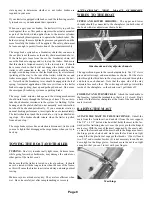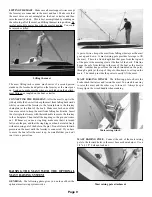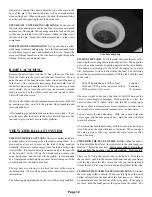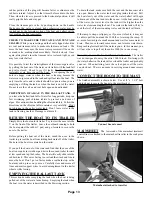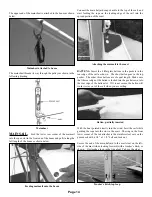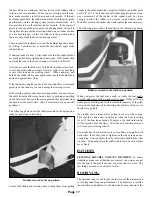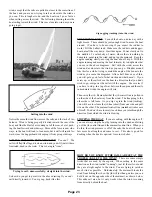
MacGregor Yacht Corp. and MacGregor does not authorize the
dealer or any other person to assume for MacGregor Yacht Corp.
any liability in connection with such warranty or any liability or
expense incurred in the replacement or repair of its products other
than those expressly authorized herein.
MacGregor reserves the right to improve its products through
changes in design or material without being obligated to incorpo-
rate such changes in products of prior manufacture.
FOREIGN CUSTOMERS.
The foregoing limited warranty
shall be null and void (and MacGregor Yacht Corporation
expressly disclaims all warranties of any kind, express or implied,
including the implied warranty of merchantability and fitness for
a particular purpose), if a foreign customer (in other words, a
retail customer not located in the United States or Canada) pur-
chases a MacGregor boat and/or trailer directly from a United
States dealer of MacGregor Yacht Corporation rather than from an
authorized foreign dealer of MacGregor Yacht Corporation.
The terms of the above paragraph are necessary because of the
extremely complex legal and certification requirements of most
foreign countries. It is essential for our protection and for the pro-
tection of the customer that foreign sales and service are handled
by authorized foreign dealers who thoroughly understand the
complex rules of the countries in which they sell, and who can
modify the boats to meet these requirements.
DEALER’S RESPONSIBILITY.
The processing of claims
against the transportation company for any damage occurring dur-
ing shipment, or by deliberate act of vandalism or by normal
intransit hazards shall be the dealer’s responsibility. MacGregor
Yacht Corporation’s responsibility for safety against damage to
the boat ceases at the time the boat leaves the MacGregor Yacht
Corp. facility; thereafter responsibility is either that of the com-
mon carrier or the dealer.
The dealer must fill out and return to MacGregor, within ten days
after the boat is sold to a retail customer, the attached Warranty
Registration Card.
It is further the responsibility of the dealer to furnish guidance and
information to the purchaser on matters pertaining to service and
maintenance during the warranty period, and in addition to
process any claims under the warranty to MacGregor Yacht Corp.
The dealer is responsible for making sure that the owner receives
the Owner’s Instructions and understands all information con-
tained therein.
OWNER’S RESPONSIBILITY.
The Owner’s Instructions, as
well as any instructions furnished with any accessories installed
on the boat, shall be placed in a large envelope and remain aboard
the boat. Purchasers should make special effort to make sure that
this literature is delivered to them by the dealer or MacGregor
Yacht Corporation. Careful attention to these instructions will add
many years to the life of the boat and equipment. It is understood
that all matters of service are handled with the selling dealer.
Purchaser should notify his selling dealer regarding any problems
under the warranty. The above warranties will be in effect only if
such part is promptly returned to the dealer with a sum sufficient
to pay transportation charges to the MacGregor plant. The dealer
shall be given an opportunity to supply parts needed for all repairs
for which a claim is to be made.
The purchaser agrees to use the boat in a reasonable and safe man-
ner. It is necessary for the owner or operator to use extreme cau-
tion when operating the boat in severe weather, or when trailering
and raising and lowering the mast near power lines or sources of
electrical power (contact between a power line and the mast or
rigging could cause injury or death), and when preparing the boat
for trailering. The purchaser must use care to assure that the boat
is not sailed unless the ballast tank is completely full and the valve
is closed and sealed. The purchaser must familiarize himself with
all information contained in the Owner’s Instructions, particular-
ly warnings contained in pages 1, 2, 3 and 4.
Page 21
Summary of Contents for 26 M
Page 28: ...Page 28...


